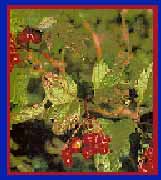

High Bush Cranberries are not related at all to Dry Ground or Swamp Cranberry. Viburnum edule, of the honeysuckle family, is also found in the region. Apparently this species is quite rare because the only reference source that mentions it is the very complete "The Flora of Churchill, Manitoba," 7th edition 1991, by Peter A. Scott.
Marilyn Walker in "Harvesting the Northern Wild" describes this fruit in some detail. "Highbush cranberry is common in moist woodlands and along the shores of lakes and streams. It is upright, deciduous, straggling shrub that grows up to seven feet high" (although maybe not up around Churchill.) The small, five-petaled flowers grow in rounded clusters, followed by the fruit. The berries are largish, bright red and juicy looking and grow in bunches. Each contains a large flattish seed from which the plant seems to derive one of its common names: "squashberry." These fruits can stay on the plant during winter if birds don't get them. Flavor is said to be improved by first frost.
Highbush cranberries resemble true cranberries in flavor and can be used in their place. They are high in vitamin C but the seeds are a drawback. Crushed and strained berries make delicious juice and excellent jelly, if pectin is added to the boiled fruit.
Walker quotes V. Richardson, an early inhabitant of the
northland, who wrote in 1852: "V. edule, the 'pembina' of the voyageurs,
was traced by us northward to the Elk River. It is much less comman than
(the true wild cranberry) and has a more fleshy and less acid fruit of an
orange-red colour. The voyageurs used to relish this fruit and it has given
name to many of the rivers of Rupert's Land. It is the Nipi-Minan (waterberry)
of the Crees."
Return toFall on the Tundra
Return to Botany intro page.
Return to Churchill, Manitoba, Canada Home Page Created 2/13/97